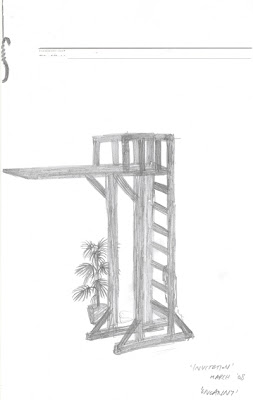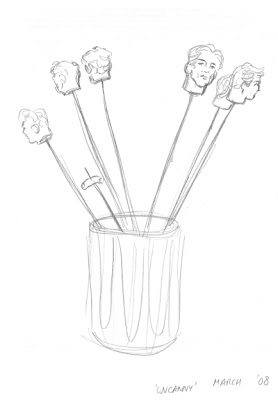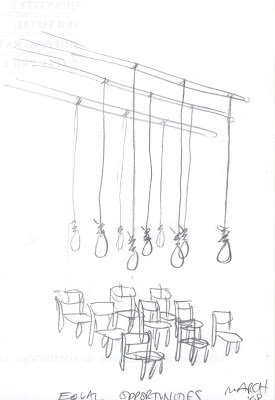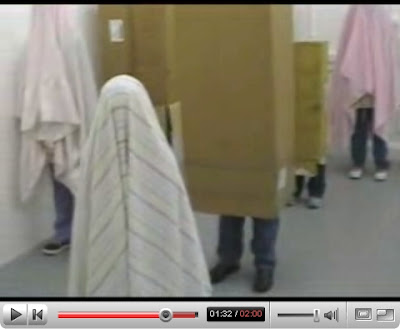Sunday, 19 October 2008
Tuesday, 23 September 2008
Child's Play 20th anniversary
Tuesday, 16 September 2008
"Screamer" video: Ghost in the London Dungeon
Reactions to Ghost in the London Dungeon

Sunday, 7 September 2008
Hans Bellmer and the omnipotence of thoughts
Are "Screamer" videos uncanny?
The uncanny is commonly associated with a creeping unease rather than a jolting shock, but how useful is this distinction in relation to "screamers" and more generally to representational media like film, video and photography?
Freud wrote, "...an uncanny experience occurs either when infantile complexes which have been repressed are once more revived by some impression, or when primitive beliefs which have been surmounted seem once more to be confirmed."
"As soon as something actually happens in our lives which seems to confirm the old, discarded beliefs we get a feeling of the uncanny; it is as though we were making a judgement something like this: 'So, after all, it is true that one can kill a person by the mere wish!' or, 'So the dead do live on and appear on the scene of their former activitie!' and so on."
When we are jolted by a sudden sound or image in a representational media (in these video clips, a sudden burst of noise and a close-up image of a maniacal face with teeth bared) it is an example of a primitive belief which has been surmounted momentarily being experienced as confirmed (ie. the belief that images can come to life). Using Freud's formulation: it is as though we were [momentarily] making a judgement something like this: 'So, after all, a picture can have the properties of what it represents,' or, 'So a video of a threatening person can lurch out of the picture into reality and actually hurt me'.
David Lynch interview parody
Ghost in Dumb and Dumber
Scary Car Commercial
Friday, 15 August 2008
Bitch Killer spoof trailer
Monday, 7 July 2008
share your creepy stories
http://www.imdb.com/title/tt0452702/board/nest/72441100
Monday, 9 June 2008
Iceberg Enters Obelisk

Iceberg Enters Obelisk is an event that will be held at the Whitechapel Gallery in London on Friday 13th June 2008.
Two figures from Attic Basement Garage will be on display in the gallery, and the evening will include a screening Porn Shoot Off Cuts.
Saturday, 7 June 2008
Baudrillard: Symbolic Exchange and Death
Our entire culture is full of this haunting of the seperated double, even in its most subtle form, as Freud gave it in 'Das Unheimliche' ('The Uncanny': 'Disturbing Strangeness' or 'Distubring Familiarity'): the anxiety that wells up around the most familiar things. Here the vertigo of seperation builds up to its greatest intensity, since this is its simplest form. There comes a moment, in fact, when the things closest to us, such as our own bodies, the body itself, our voice and our appearance, are seperated from us to the precise extent that we internalise the soul (or any other equivalent agency or abstraction) as the ideal principle of subjectivity. This is what kills off the proliferation of doubles and spirits, consigning them once again to the spectral, embryonic corridors of unconscious folklore, like the ancient gods that Christianity verteufelt, that is, transformed into demons.
By a final ruse of spirituality, this internalisation also psychologises doubles. In fact it is interpretation in terms of an archaic psychical apparatus that is the very last form of the Verteufelung, the demonic corruption and elimination of the primitive double: projection of the guilt attached to the phantasmatic murder of the other (the close relative) in accordance with the magic of the omnipotence of ideas (Allmacht der Gedanken), the return of the repressed, etc. In 'The Uncanny', Freud writes:
Our analysis of instances of the uncanny has led us back to the old, animistic conecption of the universe. This was characterised by the idea that the world was peopled with the spirits of human beings; by the subject's narcissistic overvaluation of his own mental processes; by the belief in the omnipotence of thoughts and the technique of magic based on that belief; by the attribution to various outside persons and things of carefully graded magical powers, or 'mana'; as well as by all the other creations with the help of which man, in the unrestricted narcissism of that stage of development, strove to fend off the manifest prohibitions of reality. It seems as if each one of us has been through a phase of individual development corresponding to the animistic stage in primitive men, that none of us has passed through it without preserving certain residues and traces of it which are still capable of manifesting themselves, and that everything which now strikes us as 'uncanny' fulfils the condition of touching those residues of animistic mental activity within us and bringing them back to expression.
Freud, Sigmund p.240-1 The Uncanny in Standard Edition Vol.17
Monday, 28 April 2008
Thursday, 24 April 2008
Pointer magazine advert

"Dismembered limbs, a severed head, a hand cut off at the wrist, as in a fairy tale of Hauff's, feet which dance by themselves, ... all these have something peculiarly uncanny about them, especially when, as in the last instance, they prove capable of independent activity in addition. As we already know, this kind of uncanniness springs from its proximity to the castration complex."
Freud p.244 The Uncanny
Sunday, 20 April 2008
The Unheimlich exhibition video
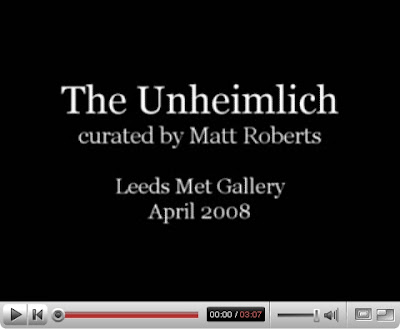
Friday, 4 April 2008
Wednesday, 2 April 2008
Bleeding Eye
 African Union troops arrest an Anjouan man after firing rockets into his house. This image appeared in The Guardian, 26 March 2008.
African Union troops arrest an Anjouan man after firing rockets into his house. This image appeared in The Guardian, 26 March 2008. '[The Sandman is] a wicked man who comes when children
won't go to bed, and throws handfuls of sand in their eyes so
that they jump out of their heads all bleeding.'
E.T.A. Hoffman 1816 The SandmanWe know from psycho-analytic experience, however, that the
fear of damaging or losing one's eyes is a terrible one in
children. Many adults retain their apprehensiveness in this
respect, and no physical injury is so much dreaded by them as
an injury to the eye. [...] A study of dreams, phantasies and
myths has taught as that anxiety about one's eyes, the fear of
going blind, is often enough a substitute for the dread of being castrated.
Sigmund Freud 1919 The Uncanny
Mugabe Mask
Wednesday, 19 March 2008
Chinese Terracotta Army protest
Tuesday, 18 March 2008
Friday, 14 March 2008
Thursday, 13 March 2008
Wednesday, 12 March 2008
Ventriloquist Dummies
 The Great Gabbo (1928) Dir. James Cruze
The Great Gabbo (1928) Dir. James Cruze
 The Ventriloquist Dummy (a segment in Dead of Night) (1945) Dir. Alberto Cavalcanti
The Ventriloquist Dummy (a segment in Dead of Night) (1945) Dir. Alberto Cavalcanti The Dummy (an episode of The Twilight Zone) (1962) Dir. Abner Biberman
The Dummy (an episode of The Twilight Zone) (1962) Dir. Abner Biberman Devil Doll (1964) Dir. Lindsay Shonteff
Devil Doll (1964) Dir. Lindsay Shonteff Profondo Rosso (Deep Red) (1975) Dir. Dario Argento
Profondo Rosso (Deep Red) (1975) Dir. Dario Argento Magic (1978) Dir. Richard Attenborough
Magic (1978) Dir. Richard Attenborough Dead Silence (2007) Dir. James Wan. Notably, the television trailer (below) for Dead Silence includes the tag line, "Just because something isn't alive doesn't mean it's dead". This recalls Jentsch's description of the uncanny effect produced by, "doubts whether an apparently animate being is really alive; or conversely, whether a lifeless object might not be in fact animate".
Dead Silence (2007) Dir. James Wan. Notably, the television trailer (below) for Dead Silence includes the tag line, "Just because something isn't alive doesn't mean it's dead". This recalls Jentsch's description of the uncanny effect produced by, "doubts whether an apparently animate being is really alive; or conversely, whether a lifeless object might not be in fact animate".Tuesday, 11 March 2008
Wittgenstein: A Family Resemblance
"We take the words out of their natural place in talking and assume they refer to some essence or ideal entity which we try to define. Because the word is uniform in appearance, we assume it refers to a uniform entity about which we can generalise. We forget the application of the word.
Take the word "good". What is common between a good joke, a good tennis player, a good man, feeling good, good will, good breeding, good looking, and a good for nothing? There is no one common property which the word good refers to.
We cannot analyze the word so that we reach some essence or element from which the concept is built up. But there are resemblances between the various meanings of the term - like family resemblances."John Heaton (paraphrasing Ludwig Wittgenstein) Introducing Wittgenstein pp.126-127
In his essay on The 'Uncanny' (1919), Freud attempts to distill a definition (or 'essence') of the term "uncanny" by analysing examples of its application. His acknowledgement of the difficulties of this approach are an example of the problem that Wittgenstein's theory of family resemblances describes:
"... the word [uncanny] is not always used in a clearly definable sense, so that it tends to coincide with what excites fear in general. Yet we may expect that a special core of feeling is present which justifies the use of a special conceptual term. One is curious to know what this common core is which allows us to distinguish as 'uncanny' certain things which lie within the field of what is frightening.
...
In his study of the 'uncanny' Jentsch quite rightly lays stress on the obstacle presented by the fact that people vary so very greatly in their sensitivity to this quality of feeling.
...
Either we can find out what meaning has come to be attached to the word 'uncanny' in the course of its history; or we can collect all those properties of persons, things, sense-impressions, experiences and situations which arouse in us the feeling of uncanniness, and then infer the unknown nature of the uncanny from what all these examples have in common."Sigmund Freud The 'Uncanny' in An Infantile
Neurosis and Other Works pp.219-220
Mike Kelley also describes collecting a group of examples of the uncanny in order to better define the meaning of the word, in the opening of his essay Playing with Dead Things: On the Uncanny (1993):
"What I'm after is a group of objects that, like the original collection of images I pinned to my wall, share an 'uncanny' quality. What this quality is, precisely, and how it functions, are difficult to describe."Mike Kelley p.26 The Uncanny
Their feeling that the word uncanny is ill-defined and provisional is indicated by the fact that both Freud and Kelley frequently place it between inverted commas.
Friday, 29 February 2008
One's own reflection
... it is interesting to observe what the effect is of meeting one's own image unbidden and unexpected. Ernst Mach has related two such observations in his Analyse der Empfindungen (1900). On the first occasion he was not a little startled when he realised that the face before him was his own. The second time he formed a very unfavourable opinion about the supposed stranger who entered the omnibus, and thought 'What a shabby-looking school-master that man is who is getting in!' - I can report a similar adventure. I was sitting alone in my wagon-lit compartment when a more than usually violent jolt of the train swung back the door of the adjoining washing cabinet, and an elderly gentleman in a dressing-gown and a travelling cap came in. I assumed that in leaving the washing-cabinet, which lay between the two compartments, he had taken the wrong direction and come into my compartment by mistake. Jumping up with the intention of putting him right, I at once realised to my dismay that the intruder was nothing but my own reflection in the looking-glass on the open door. I can still recollect that I thoroughly disliked his appearance. Instead,
therefore, of being frightened by our 'doubles', both Mach and I simply failed to recognise them as such. Is it not possible, though, that our dislike of them was a vestigial trace of the archaic reaction which feels the 'double' to be something uncanny.p.248
I slid into the self-service elevator and pushed the button for my floor. The doors folded shut like a noiseless accordion. Then my ears went funny, and I noticed a big, smudgy-eyed Chinese woman staring idiotically into my face. It was only me, of course. I was appalled to see how wrinkled and used-up I looked.p.17
'Why can't I see a mirror?''Because you better not.' The nurse shut the lid of the overnight case with a little snap.'Why?''Because you don't look very pretty.''Oh, just let me see.'The nurse sighed and opened the top bureau drawer.
She took out a large mirror in a wooden frame that matched the wood of the bureau and handed it to me.At first I didn't see what the trouble was. It wasn't a mirror at all, but a picture.You couldn't tell whether the person in the picture was a man or a woman, because their hair was shaved off and sprouted in bristly chicken-feather tufts all over their head. One side of the person's face was purple, and bulged out in a shapeless way, shading to green along the edges, and then to a sallow yellow. The person's mouth was pale brown, with a rose-coloured sore at either corner.The most startling thing about the face was its supernatural conglomeration of bright colours.I smiled.The mouth in the mirror cracked into a grin.A minute after the crash another nurse ran in. She took one look at the broken mirror, and at me, standing over the blind, white pieces, and hustled the young nurse out of the room.pp.167-8
'You are the last man,' said O'Brien. 'You are the guardian of the human spirit. You shall see yourself as you are. Take off your clothes.'Winston undid the bit of string that held his overalls together. The zip fastener had long since been wrenched out of them. He could not remember whether at any time since his arrest he had taken off all his clothes at one time. Beneath the overalls his body was looped with filthy yellowish rags, just recognisable as the remnants of under-clothes. As he slid them to the ground he saw that there was a three-sided mirror at the far end of the room. He approached it, then stopped short. An involuntary cry had broken out of him.'Go on,' said O'Brien. 'Stand between the wings of the mirror. You shall see the side view as well.'He had stopped because he was frightened. A bowed, grey-coloured, skeleon-like thig was coming towards him. Its actual appearance was frightening, and not merely the fact that he knew it to be himself. He moved closer to the glass. The creature's face seemed to be protruded, because of its bent carriage. A forlorn, jailbird's face with a nobby forehead running back into a bald scalp, a crooked nose and battered-looking cheekbones above which the eyes were fierce and watchful. The cheeks were seamed, the mouth had a drawn-in look. Certainly it washis own face, but it seemed to him that it had changed more than he had changed inside. The emotions it registered would be different from the ones he felt. He had gone partially bald. For the first moment he had thought that he had gone grey as well, but it was only the scalp that was grey. Except for his hands and a circle of his face, his body was grey
all over with ancient, ingrained dirt. Here and there under the dirt there were the red scars of wounds, and near the ankle the varicose ulcer was an inflamed mass with flakes of skin peeling off it. But the truly frightening thing was the emaciation of his body. The barrel of the ribs was as narrow as that of a skeleton: the legs had shrunk so that the knees were thicker than the thighs. He saw now what O'Brien had meant about seeing the side view. The curvature of the spine was astonishing. The thin shoulders were hunched forward so as to make a cavity of the chest, the scraggy neck seemed to be bending double under the weight of the skull. At a guess he would have said that it was the body of a man of sixty, suffering from some malignant disease.p.283-4
Thursday, 28 February 2008
Night-duty in the radar bunker
 My grandfather told a story from his time in national service, which he spent working at RAF Ringstead Radar Station, in Dorset, circa.1950. This is what my mother and I can remember of it:
My grandfather told a story from his time in national service, which he spent working at RAF Ringstead Radar Station, in Dorset, circa.1950. This is what my mother and I can remember of it:One night the man on night-duty, who had been working the shift for some months, made a radio-call to the camp. He asked to be collected at once. The job had got to him, and the following day he left the station altogether, taken away for psychiatric treatment.
Unfortunately, his apparent fearlessness did not last. Eventually he "cracked", as his predecessor had, and was likewise relieved of the post. From then on a new policy was put in place: that the night shift would always be worked by two people at a time.


(photographs courtesy of Shaun Churchill at www.worldwar2airfields.fotopic.net)
Wednesday, 27 February 2008
Kurtz in Joseph Conrad's Heart of Darkness
Similarly, Edvard Munch's painting The Scream (1893) shows a contorted face with a gaping mouth.
 Inspired by Munch's The Scream, Wes Craven's 1996 movie Scream features a killer wearing a halloween mask that also has a gaping mouth.
Inspired by Munch's The Scream, Wes Craven's 1996 movie Scream features a killer wearing a halloween mask that also has a gaping mouth. Scream (1996) Dir. Wes Craven
Scream (1996) Dir. Wes Craven
Another screaming mouth can be found in Francis Bacon's 1953 Study After Velazquez's Portrait of Pope Innocent X.

Study After Velazquez's Portrait of Pope Innocent X (1953) Francis Bacon
Tuesday, 26 February 2008
H. G. Wells' The Invisible Man
Here are some excerpts from Wells' novella:

Image: The Invisible Man (1933) Dir. James Whale
He held a white cloth - it was a serviette he had brought with him - over the lower part of his face, so that his mouth and jaws were completely hidden, and that was the reason of his muffled voice. ... all his forehead above his blue glasses was covered by a white bandage, and that another covered his ears, leaving not a scrap of his face exposed excepting only his pink, peaked nose. It was bright pink, and shiny just as it had been at first. ... The thick black hair, escaping as it could below and between the cross bandages, projected in curious tails and horns, giving him the strangest appearance conceivable. This muffled, and bandaged head was so unlike what she had anticipated, that for a moment she was rigid.
The only light in the room was the red glow from the fire - which lit his eyes like adverse railway signals, but left his downcast face in darkness - and the scanty vestiges of the day that came in through the open door. Everything was ruddy, shadowy, and indistinct to her ... for a second it seemed to her that the man she looked at had an enormous mouth wide open, - a vast and incredible mouth that swallowed the whole of the lower portion of his face. It was the sensation of a moment: the white-bound head, the monstrous goggle eyes, and this huge yawn below it.
He felt alone in the room and looked up , and there, grey and dim, was the bandaged head and huge blue lenses staring fixedly, ... It was so uncanny-looking to Henfrey that for a minute they remained staring blankly at one another.

Image: The Invisible Man Returns (1940) Dir. Joe May
The blind was down and the room dim. He caught a glimpse of a most singular thing, what seemed a handless arm waving towards him, and a face of three huge indeterminate spots on white, very like the face of a pale pansy. Then he was struck violently in the chest, hurled back, and the door slammed in his face and locked all so rapidly that he had no time to observe.
... at twilight he would go out muffled up enormously, whether the weather were cold or not, and he chose the loneliest paths and those most over-shadowed by trees and banks. His goggling spectacles and ghastly bandaged face under the penthouse of his hat, came with a disagreeable suddenness out of the darkness upon one or two home-going labourers; and Teddy Henfrey, tumbling out of the Scarlet Coat one night at half-past nine, was scared shamefully by the stranger's skull-like head (he was walking hat in hand) lit by the sudden light of the opened inn door. Such children as saw him at nightfall dreamt of bogies ...
Below, a clip from James Whale's 1933 film adaption of The Invisible Man.

Mark Seltzer Serial Killers
There is something uncanny about how these killers are so much alike, living composites, how easily they blend in. The serial killer, as one prosecutor of these cases expressed it, is "abnormally normal": "just like you or me."
An embodiment of an uncanny spatial relation, the stranger's "strangeness means that he, who is also far, is actually near". ... The stranger, if not (quite) yet the statistical person, begins to make visible the uncanny stranger-intimacy that defines the serial killer: the "deliberate stranger" or "the stranger beside me".
There is, in the experience of serial killing, a compulsive location of the scene of the crime in such homes away from home - hotel and motel spaces as murdering places. This is one indication of the radical redefinition of "the homelike" on the American scene: not exactly "no place like home," but rather only places "like" home. If stranger-killing is premised on a fundamental typicality, then the making of what came to be called, at the turn of the century, American "hotel-civilization" is premised on the mass replication of ideal-typical domestic spaces. It is premised, that is, on the uncanniness (unhomelikeness) of the domestic as such (an uncanniness perhaps inseperable from the psychic shocks of the machine culture of mass-reproducibility). Hence the repeated location of American serial violence in hotel and motel hells: the murder motel in Robert Bloch's novel Psycho, for example, or the even more lethal tourist hotel in his subsequent novel, American Gothic.
What I mean to consider here are the relays progressively articulated between bodies and places such that the home, or, more exactly, the homelike, emerges again and again as the scene of the crime.
There is no doubt always something outmoded about the domestic and its constructed nostalgias - what might be called its uncanniness, if the notion of "the uncanny" (the unhomelike) itself had not by now become an all too homey way of naming that belatedness, its ambiguous causalities and periodizations (in effect, a way of endorsing a sort of better living through ambiguity). It is the vexed status of the homelike itself that I mean to define here. More exactly, it is the way in which the public spectacle or exhibition of "the private" in machine culture - museums or replicas of home as tourist site, for instance - seems to have become inseperable from the exhibition of bodily violence or atrocity that I mean to examine. These haunted homelike places - hotel and motel hells, for example - set in high relief the "gothic" rapport between persons and spaces, the distribution of degrees of aliveness across constructed spaces, the assimilation of the animate to the inanimate and mechanic.
Sunday, 17 February 2008
Hanging Munchkin in The Wizard of Oz
 The hanging munchkin was actually the wing of a large live bird. More information about this urban legend here.
The hanging munchkin was actually the wing of a large live bird. More information about this urban legend here.
Wednesday, 13 February 2008
Thursday, 7 February 2008
Ghost boy in Three Men and a Baby

The Ghostly Videotape
In 1990, when the 1987 film Three Men and a Baby was released on videotape, people began to notice for the first time a "ghost" image, apparently of a young boy, in the background of one scene. Stories developed explaining that the son of the owners of the New York apartment used for the film had committed suicide there and had returned as a ghostly presence that could be seen only in the film. Some viewers thought they could also see the rifle he had used to kill himself alongside the spirit; others claimed that the supposed ghost was merely a young relative of the film's director, Leonard Nimoy, who had been promised an appearance in it.
Debunking these stories, the film's producers explained that the New York "apartment" was really a soundstage in Toronto and that the image was an out-of-focus view of a cardboard cutout of actor Ted Danson, who stars in the film, used as part of the apartment decor. Rumors then began to circulate that the film's distributors themselves had started the stories in order to promote video rentals and to draw attention to their sequel Three Men and a Little Lady (1990). Unmentioned in most of the discussion of this short-lived legend was the fact that supposed spectral images of dead persons in photographs have long been a part of folk tradition. Most commonly, such images were claimed to be visible in photographs of groups of miners or other workers who had lost one or more companions in occupational accidents.
Porn Shoot Off Cuts
Dead Bodies and Cardboard is an art exhibition running from 9th - 23rd February 2008 at Elevator Gallery, London. I'm exhibiting a new video titled Porn Shoot Off-Cuts in this show.
The video is made from footage shot by cameramen at porn-shoots, using the sequences that would usually be cut out during editing. This gives a fragmentary impression of the events taking place, directing our attention to the surrounding environment, and the mood of the participants.










